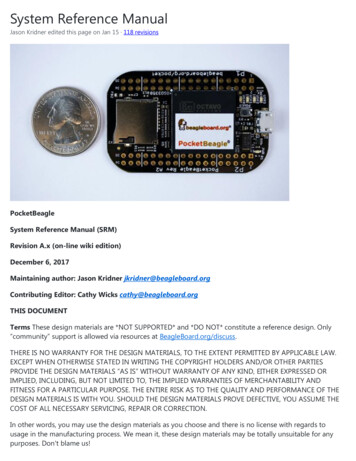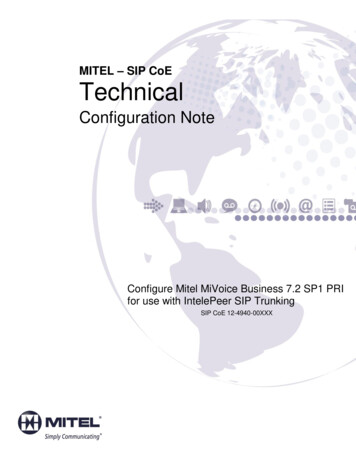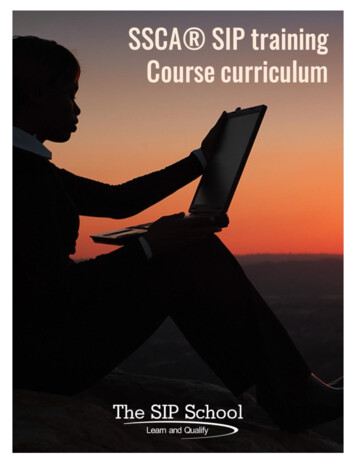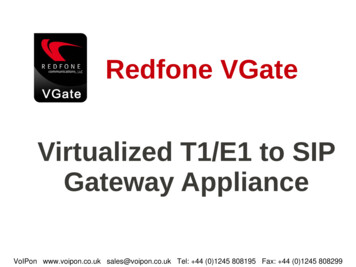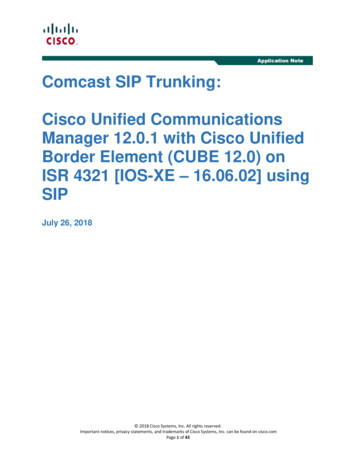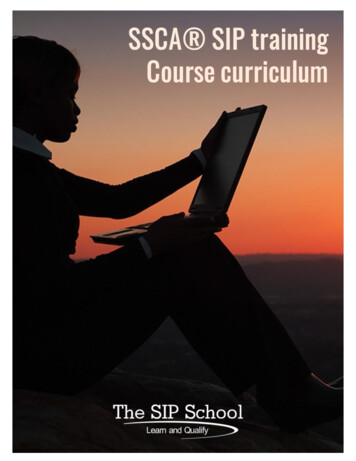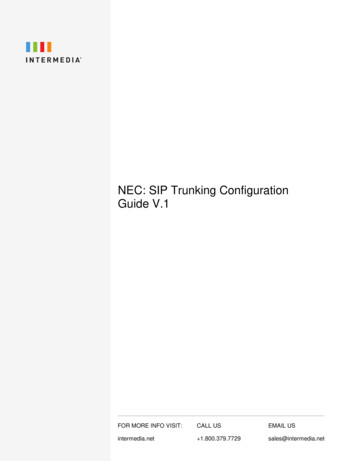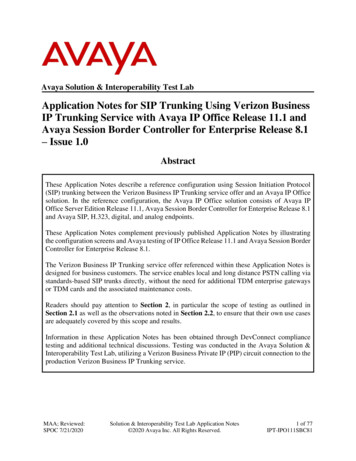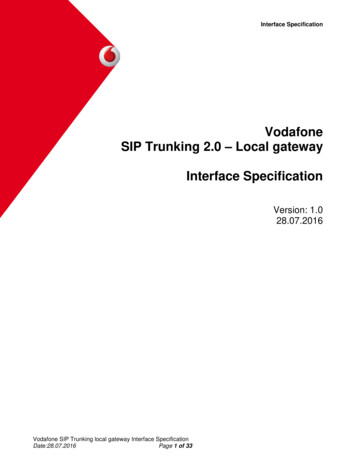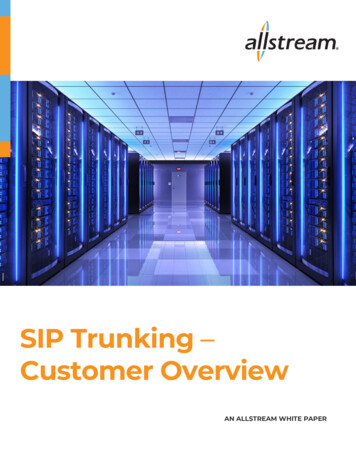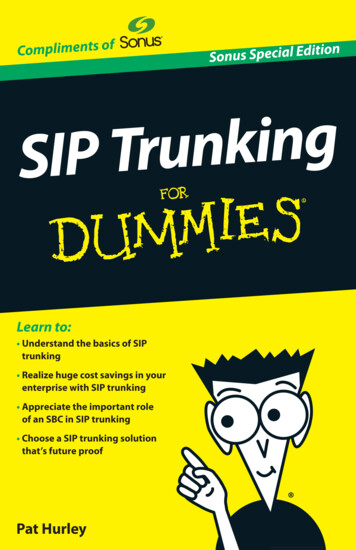
Transcription
These materials are the copyright of John Wiley & Sons, Inc. and anydissemination, distribution, or unauthorized use is strictly prohibited.
SIP TrunkingFORDUMmIES‰SONUS SPECIAL EDITIONby Pat HurleyThese materials are the copyright of John Wiley & Sons, Inc. and anydissemination, distribution, or unauthorized use is strictly prohibited.
SIP Trunking For Dummies , Sonus Special EditionPublished byJohn Wiley & Sons, Inc.111 River StreetHoboken, NJ 07030-5774www.wiley.comCopyright 2012 by John Wiley & Sons, Inc., Hoboken, New JerseyPublished by John Wiley & Sons, Inc., Hoboken, New JerseyNo part of this publication may be reproduced, stored in a retrieval system or transmitted in anyform or by any means, electronic, mechanical, photocopying, recording, scanning or otherwise,except as permitted under Sections 107 or 108 of the 1976 United States Copyright Act, without theprior written permission of the Publisher. Requests to the Publisher for permission should beaddressed to the Permissions Department, John Wiley & Sons, Inc., 111 River Street, Hoboken, NJ07030, (201) 748-6011, fax (201) 748-6008, or online at http://www.wiley.com/go/permissions.Trademarks: Wiley, the Wiley logo, For Dummies, the Dummies Man logo, A Reference for the Restof Us!, The Dummies Way, Dummies.com, Making Everything Easier, and related trade dress aretrademarks or registered trademarks of John Wiley & Sons, Inc. and/or its affiliates in the UnitedStates and other countries, and may not be used without written permission. Sonus and the Sonuslogo are registered trademarks of Sonus. All other trademarks are the property of their respectiveowners. John Wiley & Sons, Inc., is not associated with any product or vendor mentioned in thisbook.LIMIT OF LIABILITY/DISCLAIMER OF WARRANTY: THE PUBLISHER AND THE AUTHOR MAKENO REPRESENTATIONS OR WARRANTIES WITH RESPECT TO THE ACCURACY ORCOMPLETENESS OF THE CONTENTS OF THIS WORK AND SPECIFICALLY DISCLAIM ALLWARRANTIES, INCLUDING WITHOUT LIMITATION WARRANTIES OF FITNESS FOR APARTICULAR PURPOSE. NO WARRANTY MAY BE CREATED OR EXTENDED BY SALES ORPROMOTIONAL MATERIALS. THE ADVICE AND STRATEGIES CONTAINED HEREIN MAY NOT BESUITABLE FOR EVERY SITUATION. THIS WORK IS SOLD WITH THE UNDERSTANDING THATTHE PUBLISHER IS NOT ENGAGED IN RENDERING LEGAL, ACCOUNTING, OR OTHERPROFESSIONAL SERVICES. IF PROFESSIONAL ASSISTANCE IS REQUIRED, THE SERVICES OF ACOMPETENT PROFESSIONAL PERSON SHOULD BE SOUGHT. NEITHER THE PUBLISHER NORTHE AUTHOR SHALL BE LIABLE FOR DAMAGES ARISING HEREFROM. THE FACT THAT ANORGANIZATION OR WEBSITE IS REFERRED TO IN THIS WORK AS A CITATION AND/OR APOTENTIAL SOURCE OF FURTHER INFORMATION DOES NOT MEAN THAT THE AUTHOR ORTHE PUBLISHER ENDORSES THE INFORMATION THE ORGANIZATION OR WEBSITE MAYPROVIDE OR RECOMMENDATIONS IT MAY MAKE. FURTHER, READERS SHOULD BE AWARETHAT INTERNET WEBSITES LISTED IN THIS WORK MAY HAVE CHANGED OR DISAPPEAREDBETWEEN WHEN THIS WORK WAS WRITTEN AND WHEN IT IS READ.For general information on our other products and services, please contact ourBusiness Development Department in the U.S. at 317-572-3205. For details on how tocreate a custom For Dummies book for your business or organization, contact info@dummies.biz. For information about licensing the For Dummies brand for products orservices, contact BrandedRights&Licenses@Wiley.com.ISBN: 978-1-118-48767-9 (pbk)ISBN: 978-1-118-48824-9 (ebk)Manufactured in the United States of America10 9 8 7 6 5 4 3 2 1These materials are the copyright of John Wiley & Sons, Inc. and anydissemination, distribution, or unauthorized use is strictly prohibited.
Contents at a GlanceIntroduction. 1Chapter 1: Getting Acquainted with SIP Trunking. 5Chapter 2: Seeing the Benefits of SIP Trunking. 13Chapter 3: Reaping the ROI Benefits of SIP Trunking. 21Chapter 4: Taking a Peek at SIP Trunking Considerations. 31Chapter 5: Ten Reasons to Choose Sonus SBCs for SIP Trunking. 39These materials are the copyright of John Wiley & Sons, Inc. and anydissemination, distribution, or unauthorized use is strictly prohibited.
Table of ContentsIntroduction . . . . . . . . . . . . . . . . . . . . . . . . . . . . . . . . . . . . . . 1About This Book. 1How This Book Is Organized. 2Icons Used in This Book. 3Chapter 1: Getting Acquainted with SIP Trunking . . . . . 5Introducing Enterprise PBX Trunking. 6Understanding the Types of Enterprise PBX Trunking. 6Going Digital with PRI. 7Entering the SIP world. 7Understanding How SIP Trunking Works. 7Introducing the Components of SIP Trunking. 9IP PBX. 9Session border controllers. 9Session Management System. 11ITSP /SIP service provider. 11Chapter 2: Seeing the Benefits of SIP Trunking . . . . . . 13Unifying Your Access Network. 13Making management easier. 15Simplifying growth. 15Deploying SIP Services More Easily. 16Enabling Cloud-Based Services. 17Making Your Network More Reliable and Resilient. 18Going Local and Eliminating 800. 19Chapter 3: Reaping the ROI Benefits of SIP Trunking. . . . . 21Making the Case for Migrating to SIP Trunking. 21Aggregation of trunks. 22Aggregation of access. 24On-Net calling. 24Other cost savings. 25Looking at Case Studies. 26Case Study #1: The global company. 26Case Study #2: The bank. 27Case Study #3: The airline. 28These materials are the copyright of John Wiley & Sons, Inc. and anydissemination, distribution, or unauthorized use is strictly prohibited.
Table of ContentsChapter 4: Taking a Peek at SIP TrunkingConsiderations . . . . . . . . . . . . . . . . . . . . . . . . . . . . . . . . 31Considering Your ITSP. 31Pricing and pricing structure. 32Dealing with DID and local calls. 33Dispersing aggregation points. 33Quality of service. 34Blocking. 34Codecs. 34Agreements. 35Considering Your SBC. 35Chapter 5: Ten Reasons to Choose Sonus SBCsfor SIP Trunking . . . . . . . . . . . . . . . . . . . . . . . . . . . . . . . 39A Leader in SIP Communications. 39Networked Policy Management for SBCs. 39Highest Performance. 40Better Transcoding Support. 40Scalability. 41Support for Future Apps through Media Support. 41Ironclad Security. 41Guaranteed Interoperability. 42Robust Session Management. 42A Complete Package. 42These materials are the copyright of John Wiley & Sons, Inc. and anydissemination, distribution, or unauthorized use is strictly prohibited.v
Publisher’s AcknowledgmentsWe’re proud of this book and of the people who worked on it. For details on how tocreate a custom For Dummies book for your business or organization, contact info@dummies.biz. For details on licensing the For Dummies brand for products orservices, contact BrandedRights&Licenses@Wiley.com.Some of the people who helped bring this book to market include the following:Acquisitions, Editorial, and VerticalWebsitesProject Editor: Carrie A. BurchfieldEditorial Manager: Rev MengleAcquisitions Editor: Katie MohrBusiness Development Representative:Sue BlessingCustom Publishing Project Specialist:Michael SullivanComposition ServicesSr. Project Coordinator: Kristie ReesLayout and Graphics: Christin SwinfordProofreaders: Melissa Cossell,John GreenoughPublishing and Editorial for Technology DummiesRichard Swadley, Vice President and Executive Group PublisherAndy Cummings, Vice President and PublisherMary Bednarek, Executive Director, AcquisitionsMary C. Corder, Editorial DirectorPublishing and Editorial for Consumer DummiesKathleen Nebenhaus, Vice President and Executive PublisherComposition ServicesDebbie Stailey, Director of Composition ServicesBusiness DevelopmentLisa Coleman, Director, New Market and Brand DevelopmentThese materials are the copyright of John Wiley & Sons, Inc. and anydissemination, distribution, or unauthorized use is strictly prohibited.
IntroductionMost enterprises are familiar with VoIP (Voice overIP) and probably have begun at least thinking aboutimplementing Unified Communications (UC) — a suite ofintegrated voice, video, data, and text communicationsdelivered via the VoIP protocol known as Session InitiationProtocol (SIP). In fact, many enterprises have begun to deploythese services but are still connecting their primary voicecommunications systems called Private Branch Exchanges(PBX) by using legacy Time Division Multiplexing (TDM) T1lines. This approach adds cost and complexity and makesyour network less ready for taking the next step in UC.A better way to connect PBXs is to move past those expensiveT1s and on to an integrated Internet Protocol (IP) networkusing SIP trunking. SIP Trunking For Dummies, Sonus SpecialEdition, is here to help you understand this transition withsome timely information about SIP trunking, the serviceproviders and equipment that enable it, and the benefitsyou gain when you make your move to SIP trunking.About This BookSIP Trunking For Dummies, Sonus Special Edition, is notwritten as a technical manual for telecom engineers lookingfor deep techie knowledge or tips for planning SIP trunkingdeployment — there are plenty of 600-page technical booksfor those purposes. Instead, you’ll find that this book is designedfor the non-technical folks — marketers, sales professionals,finance wizards, and so on — in mid- and large-sized enterpriseswho want to save money and enable new UC services byadopting a SIP trunking solution. If you know a little bit aboutSIP trunking today, I think you’ll know more when you’vefinished reading, and if you know nothing, don’t worry; I walkyou through all you need to know before you take that salescall or put out your Request for Proposal (RFP).These materials are the copyright of John Wiley & Sons, Inc. and anydissemination, distribution, or unauthorized use is strictly prohibited.
2SIP Trunking For Dummies, Sonus Special EditionHow This Book Is OrganizedThis book is organized into five chapters. As is the case in anyFor Dummies book, each of these chapters is self-contained,so you don’t need to read the entire book from start to finish.If you see a chapter that you already know everything about,feel free to skip it. Whenever a complex topic from anotherchapter is raised, you see a reference to that chapter — noneed to spend your time digging around in the table of contents.Chapter 1: Getting Acquaintedwith SIP TrunkingChapter 1 introduces you to SIP trunking and trunking ingeneral. In this chapter, you discover enterprise PBX trunkingand how SIP trunking fits in with traditional methods like TDMtrunking over T1s. Then you learn how SIP trunking actuallyworks and what components you need to implement it.Chapter 2: Seeing the Benefitsof SIP TrunkingChapter 2 is where you find the (many) benefits of adoptingSIP trunking, with a focus on operational rather than monetarybenefits. SIP trunking can simplify the management of yournetwork and enable the deployment of new UC services. SIPtrunking can also help you adopt cloud-based services.Chapter 3: Reaping the ROIBenefits of SIP TrunkingSIP trunking is a huge money saver for many enterprises —saving many as much as 50 percent on their recurring telecomcosts. In this chapter, you discover what these Return onInvestment (ROI) benefits are all about. You’ll also see somereal-world case study examples from three enterprises thatsuccessfully implemented SIP trunking. If you’re in finance orhave a budget to worry about, you’ll enjoy this chapter.These materials are the copyright of John Wiley & Sons, Inc. and anydissemination, distribution, or unauthorized use is strictly prohibited.
IntroductionChapter 4: Taking a Peek at SIPTrunking ConsiderationsIn Chapter 4, you find out the questions to ask and the thingsto consider before you commit to a SIP trunking deploymentand when you choose an Internet Telephony Service Provider(ITSP) to provide your SIP trunking service. You also see theimportant considerations to keep in mind when selecting aSession Border Controller (SBC).Chapter 5: Ten Reasons to ChooseSonus SBCs for SIP TrunkingIf you read Chapters 1 through 4, I hope you’re sold on SIPtrunking and also have a good idea about what makes a goodSIP trunking solution. But even if you haven’t, Chapter 5 iswhere you look at some of the attributes of the SBCs offeredby Sonus and understand how Sonus SBCs may match up wellwith your SIP trunking needs.Icons Used in This BookThis book calls out important bits of information with iconson the left margins of the page. You’ll find three such icons inthe book.The Tip icon points out bits of information that aid in yourunderstanding of SIP trunking or provides a trick of the tradeto help save you time, money, and much more.The Remember icon points out textual tidbits that you shouldlock away in your memory for future use.I try to keep the technical jargon and discussion to a minimum.You won’t need to know these factoids to get the most out ofthe book, but you may find them interesting.These materials are the copyright of John Wiley & Sons, Inc. and anydissemination, distribution, or unauthorized use is strictly prohibited.3
4SIP Trunking For Dummies, Sonus Special EditionThese materials are the copyright of John Wiley & Sons, Inc. and anydissemination, distribution, or unauthorized use is strictly prohibited.
Chapter 1Getting Acquainted withSIP TrunkingIn This Chapter Saying hello to PBX trunking Digging deeper into enterprise PBX trunks Discovering how SIP trunking works Learning the components of SIP trunkingEnterprises of all kinds are dealing with two big trendswhen it comes to their real-time communicationsneeds. First, they’re trying to save money in an era when justabout every business is tightening its belt. Second, they’retrying to figure out how to support a host of new unifiedcommunications applications in an era where new devices,mobile connections, and more sophisticated users aredemanding change right now.In this chapter, you learn about a technology being consideredby many enterprises that meets both of those goals: SessionInitiation Protocol (SIP) Trunking. First, I discuss enterprisePrivate Branch Exchange (PBX) Trunking in general and thenthe difference between circuit-switched and SIP trunking.I follow that by then digging deeper into SIP trunking andlooking at the components required. By the end of thischapter, you should have a pretty good idea what SIP trunkingis all about.These materials are the copyright of John Wiley & Sons, Inc. and anydissemination, distribution, or unauthorized use is strictly prohibited.
6SIP Trunking For Dummies, Sonus Special EditionIntroducing EnterprisePBX TrunkingMany enterprises — in fact, I’d say most medium and largeenterprises — use a PBX telephone system to provide voiceand other communications services to their employees. Youknow what I’m talking about if you dial “9” first to get anoutside line or if you can dial a coworker with just a few of thedigits of her phone number.The telecommunications network connections that connectthe PBX to a telephone service provider are known as trunks.The name implies a tree analogy that explains what a trunk is:all of the individual lines (phones on peoples’ desks) are thebranches of the tree, connected to a bigger line (the trunk),which connects back to the network. Trunking is a big dealbecause it lets an enterprise pay for fewer phone “lines” thanit has users with phones — the PBX lets a larger number ofusers and stations effectively share a smaller number ofconnections to the outside world — it’s sort of the time shareof the phone world, but you get to use it more than two weeksa year.The thing to remember about enterprise voice trunking isthat it’s an efficient and cost-effective alternative to buyingan individual phone line for every person in the enterprise.Imagine both the cost and the management hassle of thatapproach.Understanding the Types ofEnterprise PBX TrunkingFor many decades, PBX trunks were traditional analog circuitswitched voice lines just like the ones you may buy from yourlocal phone company for your home. For example, a smallbusiness may purchase three lines from the phone company,connect them to a small business phone system (essentiallya mini-PBX, sometimes called a key system) and then sharethose lines among the six or seven people (extensions) in theoffice.These materials are the copyright of John Wiley & Sons, Inc. and anydissemination, distribution, or unauthorized use is strictly prohibited.
Chapter 1: Getting Acquainted with SIP TrunkingGoing Digital with PRIAnother option for connecting a PBX to a telephone carrieris known as a Primary Rate Interface (PRI) line. PRI is a TimeDivision Multiplexing (TDM) interface, provided over standardtelecommunications copper or fiber lines. PRI uses a T1interface in North America or an E1 interface in other parts ofthe world.T1 and E1 lines are carved into 23 or 30 individual voice lines,respectively. Essentially, a T1 or E1 is a souped-up phone linethat can carry multiple voice lines over a single pair (or pairof pairs, in some cases) of copper phone lines, by using somedigital trickery to divide the voice signals up by time slots. Allthe extensions in the office connect to the PBX, which thenconnects to one or more PRIs and on to the phone companynetwork.Entering the SIP worldThe PRI system worked well for a long time, but a moreefficient (in terms of both bandwidth utilization and cost) andmodern system has begun to replace circuit switched voice:SIP trunks, which utilize Voice over IP (VoIP) and the SIP.SIP trunking uses a data connection — the same connectionthat a business uses for Internet access, for connecting tocloud services, or for hosting its e-commerce site — to carryvoice signals as VoIP to a service provider who can handlethat kind of voice signal.A carrier who can offer VoIP services is called an InternetTelephony Service Provider (ITSP). An ITSP could do justthat, or it could be your familiar local and long distancecarrier who offers VoIP services in addition to moretraditional circuit-switched voice services.Understanding How SIPTrunking WorksSIP trunking relies on Internet protocols and Internet servicesinstead of old-fashioned circuit-switched voice protocolsThese materials are the copyright of John Wiley & Sons, Inc. and anydissemination, distribution, or unauthorized use is strictly prohibited.7
8SIP Trunking For Dummies, Sonus Special Editionand services. With SIP trunking, voice communications canbe merged with the data services an enterprise uses. In fact,many smaller enterprises merge their voice and data onto asingle “Internet” data connection while larger enterprises maykeep them separate but save significant amounts of money byusing cheaper data services for voice instead of TDM trunking.In other words, voice (and related communications servicessuch as video, which I discuss in Chapter 2, when I talk aboutUnified Communications, or UC) is just another data servicebeing delivered over an enterprise’s data network.A good way to understand this concept is to think about thephone functionality on your Android, Windows, or iPhonesmartphone. It’s just another one of the apps on the phone,instead of a dedicated hardware device. When you want tocheck Facebook comments, you click the Facebook app, andwhen you want to make a call, you click the Phone app (or theSkype app, for that matter).The key protocol that supports VoIP connections is SIP andis basically the controller of calls (and other UC sessions).Here’s a way of understanding SIP: Think of your voice as adata connection, and your language (like English) is theprotocol that lets other people understand your voice. SIPisn’t the only language (there are others such as H.323), butit’s the most common. SIP relies on clients and servers in thenetwork to exchange information about the following: Who’s connected to the network? Where are they located? What resources are available to them (in other words,what applications can they access and use, and whatkind of phone or device are they using)? Who’s inviting people to begin a session, if they accept,and when are they done?A SIP trunk is a virtual connection between an InternetProtocol Private Branch Exchange (IP PBX) and a telephoneservice provider providing SIP-based voice and UC services,connected over an enterprise’s data network connections.These materials are the copyright of John Wiley & Sons, Inc. and anydissemination, distribution, or unauthorized use is strictly prohibited.
Chapter 1: Getting Acquainted with SIP TrunkingIntroducing the Componentsof SIP TrunkingSome of the components needed to implement SIP trunkingare hardware devices that you need installed on your network,while another component is the service itself, provided by athird-party service provider. I cover those components inthis section, but Figure 1-1 shows some of the necessarycomponents in a typical deployment.Figure 1-1: SIP trunking components.IP PBXThe key element to SIP trunking is a phone system that canconvert voice calls into VoIP calls for transmission across theSIP trunk. While there are other devices out there that can dothis job — various VoIP gateway type devices, for example —the most common and cost-effective mechanism is an IP PBX.Session border controllersA key element of a SIP trunking solution — and I do meankey — is the Session Border Controller (SBC). The SBC is theThese materials are the copyright of John Wiley & Sons, Inc. and anydissemination, distribution, or unauthorized use is strictly prohibited.9
10SIP Trunking For Dummies, Sonus Special Editiondevice that sits on the border between an enterprise’sprivate network and the public network provided by data andtelephony service providers. The SBC plays a few very vitalroles in managing SIP traffic for voice and other UC servicesand applications, including the following: Security: SBCs protect the network against threats by Protecting against Denial of Service and DistributedDenial of Service “flood” attacks, which attempt tooverload network components and prevent voiceservices Preventing unwanted ingress into the network(SBCs “hide” the topology and network addressesof devices “inside” the enterprise network) — youdon’t want everyone coming in and making callsfrom your IP PBX Providing encryption for sessions traveling acrossthe network, especially if you care about peopleeavesdropping on you Protecting against toll fraud from malicious outsideusers accessing the network Routing: The SBC provides inter-network connectivity toallow remote workers to make phone calls and also allowolder IP devices to be used on your network. Quality of Service: The SBC keeps an eye on overallnetwork utilization and on the policy-based prioritiesfor different applications and users. It also determines ifand when sessions should occur and what priority andamount of bandwidth they should be assigned — all onthe fly. SIP translation: Different vendors have slightly differentdialects of SIP — an SBC can “speak” these differentdialects and allow uninterrupted connectivity betweendifferent network segments. Transcoding and transrating: The SBC can actuallymodify the “payload” or content of SIP sessions tochange codecs (coder and decoders) and change bitrates to make sure both ends of a SIP session cancommunicate, regardless of what kind of client or networkis in use.These materials are the copyright of John Wiley & Sons, Inc. and anydissemination, distribution, or unauthorized use is strictly prohibited.
Chapter 1: Getting Acquainted with SIP Trunking11Session Management SystemAn optional but often very useful addition to a SIP trunkingimplementation is a Session Management System. Withoutsession management, many or even most UC applicationswill have their own servers, their own management systems,their own policy enforcement, and their own policy databasesystems — each of these elements individually controlledand managed. Session management brings all these elementsunder a single system’s control, saving time and money.Session management has an additional benefit: It providesintermediation and federation (in the computing sense, notthe political one) between different platforms, different networks, and different geographies. So a session managementsystem makes it easy for a UC application to be deployed onetime and then provided to users (based on policies) no matterwhere they are, what device they are using, what kind of IPPBX is installed in their office, and so on. This ability tocentrally and quickly deploy new applications is a big deal forenterprises with heterogeneous network infrastructures —like companies who’ve merged or with subsidiaries who “didtheir own thing” when they built their networks.Session management isn’t a “must have” for SIP trunking, butit’s a problem solver for complex UC deployments. Sessionmanagement is something you definitely should consider asyou move from a simple voice-centric UC deployment andstart adding new multimedia apps.ITSP/SIP service providerYour SIP sessions — whether they’re voice calls, videoconferences, multimedia sessions, or whatever (the sky’sthe limit) — need a public network provider to get to wherethey’re going if they’re not internal calls handled on your ownenterprise network. That’s the role of a service provider —just as it was with traditional circuit-switched voice.A service provider that provides transport and terminationof SIP calls is the ITSP — sometimes also called a SIP serviceprovider. You can really think of an ITSP as just a “phoneThese materials are the copyright of John Wiley & Sons, Inc. and anydissemination, distribution, or unauthorized use is strictly prohibited.
12SIP Trunking For Dummies, Sonus Special Editioncompany,” with the difference being their interface with yournetwork (through your SBC and onto your IP PBXs) is adata connection using SIP to control the flow and routing ofsessions.In fact, many traditional phone companies are beginning tooffer SIP trunking services to their enterprise customers —after all, if someone is going to cannibalize your legacycircuit-switched voice services, it may as well be your owncompany, right?In its doorman role, the SBC first and foremost determineswhich sessions should even be allowed on and off theprivate portion of the network. So “spam” calls or calls fromblacklisted users (like telemarketers) can just be stopped atthe door and not allowed in, while other sessions can alwaysbe connected (whitelisted) or connected when certainconditions are met (greylisted). Additionally, the doormanpart of the SBC also determines what UC applications asession can access, based on policy, availability, and thecapabilities of the clients on either end of the connection.Seeing the role of an SBCin SIP trunkingThe SBC is essentially the trafficcop and doorman of SIP trunking.In its first role (traffic cop), the SBClooks at each individual sessioncrossing between the internalenterprise network and the externalITSP network and determines whereand when that session shouldgo — in other words, where thesession should be routed and whatpriority the session will be assignedwhen the network is busy. The SBCalso determines how many lanes(how much bandwidth) should beassigned to a session, based onnetwork utilization and the policiesestablished for the network.Finally — and perhaps mostimportantly — the SBC performs SIPinterworking, which allows devicesthat use subtly different variants ofSIP to communicate with each othereffe
SIP Trunking For Dummies, Sonus Special Edition, is not written as a technical manual for telecom engineers looking for deep techie knowledge or tips for planning SIP trunking deployment — there are plenty of 600-page technical books for those purposes. Instead, you'll find that this book is designed
